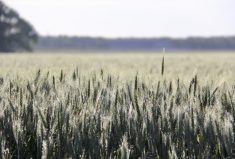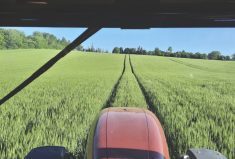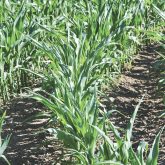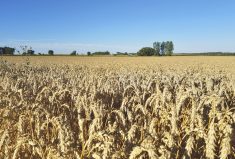The Great Lakes YEN, or Yield Enhancement Network: get used to the term because you’re going to hear more about it.
The project originated in the United Kingdom, where growers, agronomists, advisors, researchers and extension personnel have been working collaboratively since 2012 to improve wheat yields and focus on practices to increase on-farm efficiencies.
Conceived by the U.K.’s Agricultural Development and Advisory Service (ADAS), the initiative began garnering interest in Ontario following a presentation at the 2020 Southwest Agricultural Conference. In its early stages, it was decided the Great Lakes project would mirror the U.K.’s and bring together participants from Ontario, Michigan and Ohio.
Read Also

Sensing the soil: Root cell research finds ‘stress hormone’
Research into how root cells react to soil stressors could help plants better adapt to changes in their climate.
The Great Lakes YEN partners are Michigan State University, Michigan Wheat Program, Grain Farmers of Ontario, the Ontario Ministry of Agriculture, Food and Rural Affairs (OMAFRA), University of Guelph and Certified Crop Advisors. After discussions and planning in 2020, the management team initiated its pilot project in 2021 to test the system and gauge responses and outcomes among participants. There’s also a friendly competition involved alongside a valued opportunity to learn, not just from a grower’s own results but a willingness to share details with others taking part.
“The way I look at this is that each individual (or group) doesn’t have all the answers,” says Joanna Follings, cereal crops specialist with OMAFRA. “But when you come together with all of your strengths and resources, it makes a project that much better. We have the same goal so you’re able to learn from one another, and in my opinion, you’re able to reach your goal much quicker.”
First-year success
If the results from 2021 are any indication, Great Lakes YEN is only going to become bigger for those involved. In all, 43 farm sites were included in the pilot project: 23 in Ontario, 18 in Michigan and two in Ohio. Each participant submitted a soil sample, two tissue samples and a grab sample of 100 shoots at maturity. Grower participants could weigh the harvested acreage with a third-party verifier. Yield monitor data were unacceptable.
Josh Nasielski from the University of Guelph helped formulate the wheat crop models for the region and allowed the management team from the four partners to develop the data from the project to align with those of the U.K.’s initiative. Nasielski adapted Great Lakes conditions to include solar radiation capture, weather and the length of the growing season in making the appropriate measurements.
At the end of the 2021 competition, three prizes were awarded for highest yield and three for achieving the highest percentage of potential yield (see below). Although yield is the familiar standard, it was hoped the achievement of potential yield would entice growers to assess or compare management practices in-season and carry those forward into subsequent years’ competitions.

Yield is held as the truest measure of success and may be easiest to quantify. Yet determining percentage of potential yield and any measurable attributes could help with creating on-farm efficiencies. That might mean more frequent nitrogen applications or adjustments to fungicide timing. Although they’re simple concepts, Follings notes the pendulum is beginning to swing, with a “less is more” approach being encouraged and adapted by some.
“First and foremost, yield is one metric and there are so many other measures of success beyond it, and we’ve always tried to emphasize that,” she adds, citing profitability and soil health. “The challenge of coming up with a standardized metric is we don’t have baseline levels for certain nutrients. We’re starting with yield but we are open to more economic measures. It’s something growers told us they wanted more of.”
Costs for the pilot project were covered by Grain Farmers of Ontario and Michigan Wheat Program. For the 2022 competition, participants have paid $250 and will be required to do the soil and tissue collections.
From yield to information
Kevin Van Netten is one of the growers who initially wanted to test his skills with the yield competition, but as the year progressed and the price of wheat increased, he changed his crop management strategy. He looked at different services and products to enhance the crop, adding applications to stimulate yield. When it came time to sign on to the 2022 YEN project, he was reluctant due to poor post-plant conditions last fall yet he still wanted to take part.
“Not because I expect to win again, but because the information the report brought following the crop was very worthwhile,” says Van Netten. “The entire process was excellent — the organizers were very professional and very respective of the crop, and they valued my time.”
Despite winning the yield competition with 152.8 bu./ac., Van Netten was disappointed to see his percentage of yield potential at 61.37 per cent based on a potential yield of 248.92 bu./ac. As accustomed as he was to measuring success with bushels, he decided to shift his focus to yield potential.
“Every farm has a yield potential for every crop and management now changes to bring each crop closer to our yield potential,” he adds. “We need to look at all variables and determine which ones are controllable and which are uncontrollable.”

The potential for learning among participants and organizers caught the eye of Dennis Pennington, wheat extension specialist with Michigan State University. He found some growers participated because they wanted to see how far they could push their yields and being competitive, they wanted to try to beat other growers.
“The yield competition part of this project is meant to provide that opportunity in terms of wheat yields,” says Pennington. “But this per cent of yield potential is meant to be an internal benchmark from the farm, to understand what percentage of my maximum can I achieve? If I’m at 50 per cent this year, I want to shoot for 55 per cent next year and 60 per cent the following year. It’s a way to determine the differences they’re making on their farm year to year. Yield and percent of yield are important but not everyone is about trying to ‘win’ — some are trying to increase the profitability on their farm.”
Europe versus North America
According to the Great Lakes YEN website, potential wheat yield for the U.K. is 223 bu./ac., achievable almost anywhere. For 2021, the average yield potential for the Great Lakes region was 220 bu./ac. However, grain-fill period in the U.K. is 45 to 60 days versus 30 to 40 days for Ontario. Given that fact plus differences in weather and the length of the growing seasons speaks to management practices in Ontario, Michigan or Ohio.
“When you can have an extra two weeks’ worth of time to fill that grain, you can get much higher yields,” says Pennington. “The way they’re getting that isn’t necessarily by getting more grains per unit of area but by getting higher thousand-kernel weights, which means the grains they’re producing are larger and heavier. Farmers take a load of grain to the elevator, weigh it and that’s how they get paid.”
Like the others involved in the project, Marty Vermey believes the quality of the information gleaned from participants reflects a higher value compared to boosting yields.
“That’s what we’re hoping to explore by measuring everything — number of kernels per head, size and biomass,” says Vermey, senior agronomist with the Grain Farmers of Ontario. “We need to find out what’s driving the yield to help us achieve our potential yields in our environment.”
What about corn and soybeans?
Asked whether the YEN program could be adapted for corn and soybeans, Vermey says there’s a fit, especially if it’s assumed that corn and soybean potential is higher than wheat, based on some world record yields. In 2021, Virginia farmer David Hula yielded 602.17 bu./ac. on corn, meaning Ontario’s record yield of 200 bu./ac. for 2021 was just 33 per cent of the highest yield. For soybeans, Georgia farmer Randy Dowdy set a record with 190.23 bu./ac., meaning Ontario yields for 2021 achieved only 27.4 per cent of the plant’s potential.
“We have lots of room to grow our yields,” says Vermey, noting the YEN project for Ontario reported a yield potential range from 40 to 66 per cent of potential achieved. “It’ll be about paying attention to detail and making timely decisions.”
Entries for the 2022 YEN project are closed, with more than 100 participants due to more entrants in Ohio. To view more about the project’s concept, procedures and an in-depth report on its results from 2021, go to greatlakesyen.com.
















